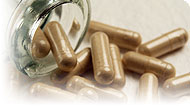Glandular Extracts
Uses
A gland is defined as a secretory organ (i.e., an organ that secretes substances into the bloodstream or elsewhere in the body). The internal secretory organs of the body are called endocrine glands. These ductless glands secrete hormones directly into the blood stream. The glands that are known to have endocrine function include the pineal, pituitary, thyroid, parathyroid, thymus, adrenal, pancreas, and gonads (testes and ovaries). Although not technically glands, other organs of the body are commonly also referred to as "glandulars" when they are taken as supplements. For example, tissue extracts of the heart, spleen, prostate, uterus, brain, and other tissues are often used in so-called "glandular therapy," along with extracts from pineal, pituitary, thyroid, parathyroid, thymus, adrenal, pancreas, and gonads. Glandular therapy refers to the use of animal tissues to try to enhance the function of, or mimic the effect of, the corresponding human tissue.
How It Works
How to Use It
The recommended amount may vary according to the potency and method of preparation of the particular product. Please consult the label on the specific glandular product.
Where to Find It
Most glandular products are derived from beef (bovine) sources, with the exception of pancreatic extracts, which are most often derived from pork (porcine). The four most widely known methods of processing are the azeotrophic method, salt precipitation, freeze-drying, and predigestion.
The azeotrophic method begins by quick-freezing the material at well below 0 degrees F, and then washing the material with a powerful solvent (ethylene dichloride) to remove the fatty tissue. The solvent is then distilled off and the material is dried and ground into a powder so that it can be placed in tablets or capsules. Although the azeotrophic method aids in the removal of fat-stored toxins (like pesticides) and toxic heavy metals, it also removes fat-soluble hormones, enzymes, essential fatty acids, and other potentially beneficial materials.
The salt precipitation method involves the maceration of fresh glandular material in a salt and water solution. Like the azeotrophic method, this process also allows the fat-soluble material to be separated out. The benefit of the salt precipitation method is that no toxic solvents are used to remove the fatty material. The down side is that the salt content can be very high, and that some of the potentially beneficial constituents may be removed.
The freeze-drying process involves quickly freezing the glandular material at temperatures 40 to 60 degrees below 0 degrees F and then placing the material into a vacuum chamber, which removes the water by direct vaporization from its frozen state—hence the term freeze-drying. The benefits of freeze-drying are that it preserves more of the unaltered protein and enzymes as well as all of the fat-soluble components. Since the fat is not removed, potentially harmful contaminants that accumulate in fat tissue may remain in the product. It is therefore critical that the glands be derived from livestock that have grazed on open ranges that are not sprayed with pesticides or herbicides. The animals should also be free of antibiotics, synthetic hormones, and infection.
The predigestion method employs the aid of plant and animal enzymes to partially digest or hydrolyze the glandular material. The partially digested material is then passed through a series of filtrations to separate out fat-soluble and large molecules. The purified material is then freeze-dried. This method of extraction is thought to be ideal for certain glandulars, such as liver and thymus, where the polypeptide (small proteins) and other water-soluble fractions are desired.
Possible Deficiencies
As glandulars are not essential nutrients, no deficiency states exist.
Interactions
Interactions with Supplements, Foods, & Other Compounds
Interactions with Medicines
Side Effects
Side Effects
Last Review: 03-18-2015

Copyright © 2025 TraceGains, Inc. All rights reserved.
Learn more about TraceGains, the company.
The information presented by TraceGains is for informational purposes only. It is based on scientific studies (human, animal, or in vitro), clinical experience, or traditional usage as cited in each article. The results reported may not necessarily occur in all individuals. For many of the conditions discussed, treatment with prescription or over the counter medication is also available. Consult your doctor, practitioner, and/or pharmacist for any health problem and before using any supplements or before making any changes in prescribed medications. Information expires December 2025.



